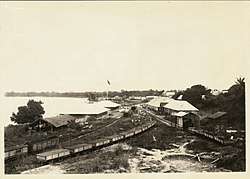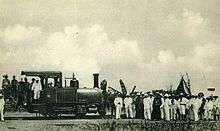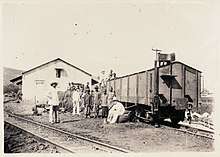Compagnie du Chemin de Fer du Congo
The Railway Company of the Congo (French: Compagnie du Chemin de Fer du Congo, or CCFC) was a narrow gauge railway company in the Congo, which built and operated the Matadi–Kinshasa Railway initially with a gauge of 750 mm.
| Compagnie du Chemin de Fer du Congo | ||||||||||||||||||||||||||||||||||||||||||||||||||||||||||||||||||||||||||||||||||||||||||||||||||||||||||||||||||||||||||||
|---|---|---|---|---|---|---|---|---|---|---|---|---|---|---|---|---|---|---|---|---|---|---|---|---|---|---|---|---|---|---|---|---|---|---|---|---|---|---|---|---|---|---|---|---|---|---|---|---|---|---|---|---|---|---|---|---|---|---|---|---|---|---|---|---|---|---|---|---|---|---|---|---|---|---|---|---|---|---|---|---|---|---|---|---|---|---|---|---|---|---|---|---|---|---|---|---|---|---|---|---|---|---|---|---|---|---|---|---|---|---|---|---|---|---|---|---|---|---|---|---|---|---|---|---|
 Congo Railways at Leopoldville, a view of the port and the train station | ||||||||||||||||||||||||||||||||||||||||||||||||||||||||||||||||||||||||||||||||||||||||||||||||||||||||||||||||||||||||||||
| Technical | ||||||||||||||||||||||||||||||||||||||||||||||||||||||||||||||||||||||||||||||||||||||||||||||||||||||||||||||||||||||||||||
| Track gauge | 750 mm (2 ft 5½ in) 765 mm (2 ft 6⅛ in) 1,067 mm (3 ft 6 in) | |||||||||||||||||||||||||||||||||||||||||||||||||||||||||||||||||||||||||||||||||||||||||||||||||||||||||||||||||||||||||||
| ||||||||||||||||||||||||||||||||||||||||||||||||||||||||||||||||||||||||||||||||||||||||||||||||||||||||||||||||||||||||||||
History

The Compagnie du Chemin de Fer du Congo (CCFC) was founded on 31 July 1887, on the same day the Compagnie du Congo pour le Commerce et l'Industrie (CCCI) was founded. The construction of the railway was directed by Albert Thys, whose name was given to one of the railway stations, Thysville (now Mbanza-Ngungu).[1]
The completion of the Matadi–Kinshasa railway, in 1898, provided an alternative route around the rapids and sparked the rapid development of Léopoldville. Its construction cost the lives of 1,932 people (1,800 locals and 132 immigrants).[1]
The main challenge was to build the railway track through the gorges of the Congo River, onwards through the M'pozo River, and a difficult passage along the Monts de Cristal.
Gauges
Starting in 1890, the railway line was initially built to a nominal gauge of 750 mm (2 ft 5½ in), and all rolling stock was constructed to this gauge. However, as local labour had difficulty understanding the concept of gauge widening on curves, the entire line was rebuilt to a gauge of 765 mm (2 ft 6⅛ in). Modifications were made from 1923 to 1931, when it was converted to 1,067 mm (3 ft 6 in) gauge on a new alignment. Several tens of thousands of workers, mostly convicts and forced labor, were employed for this renovation. 7,000 of them lost their lives in the process.[1]
In spite of the technical and financial difficulties related to the construction of the railway line, it quickly proved to be profitable, mainly thanks to the transportation of ivory and rubber. As a 750 mm (2 ft 5½ in) gauge railway it operated a large fleet of 0-6-0T, 0-6-2T, 2-6-2T steam locomotives before turning to 32 0-6-0+0-6-0 Garratts, and finally 5 outside-framed 2-8-2 locomotives.[1]
Rolling stock
- Locomotives (765mm gauge)
- N°111, Garratt 0-6-0+0-6-0, livery of the Société de Saint-Léonard in Liège, 1913 (N°1744/1913)[2]
- N°112-123, Garratt 0-6-0+0-6-0, livery of the Saint-Léonard à Liège, 1920-21 (N°1901-1902/1920)
- N°125-132, Garratt 0-6-0+0-6-0, livery of the Saint-Léonard à Liège, 1924 (N°2001-2009/1924)
- N°132-142, Garratt 0-6-0+0-6-0, livery of the Saint-Léonard à Liège, 1925 (N°2040-49/1925)
The railway in literature

Joseph Conrad witnessed the hard labour on the railway line, when he worked in the Congo Free State, and subsequently mentioned this in his well-known novel Heart of Darkness.[1]
References
- Historical Railway: Congo Railways - Leopoldville - a view of the port and the train station.
- "Archived copy". Archived from the original on 2012-03-13. Retrieved 2017-10-24.CS1 maint: archived copy as title (link)